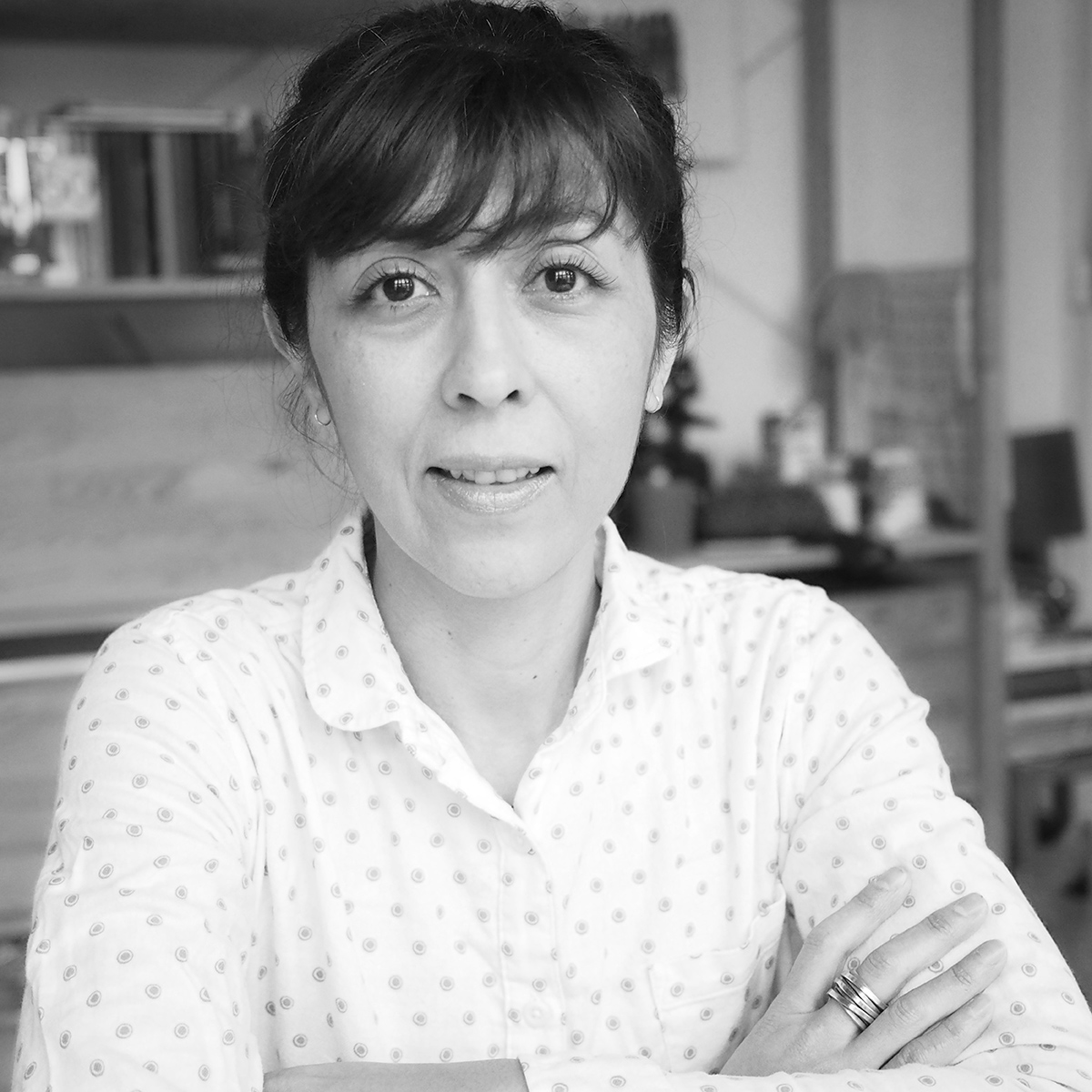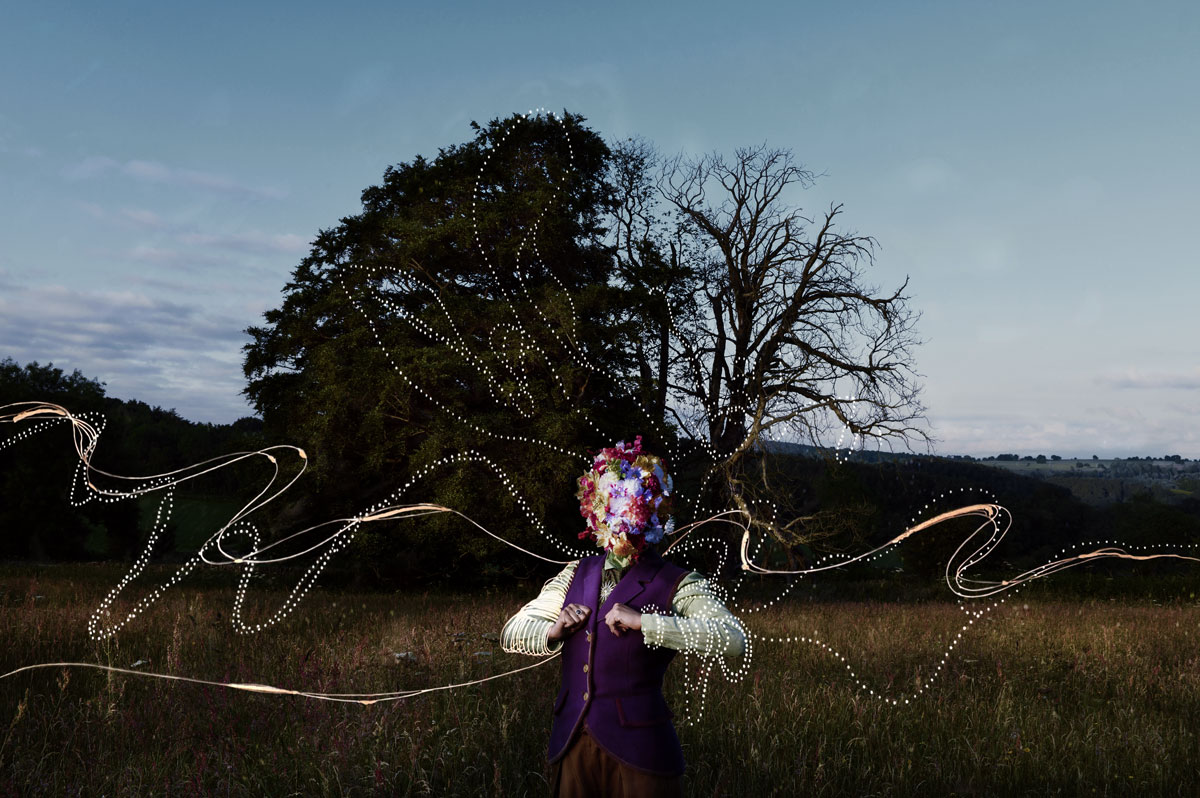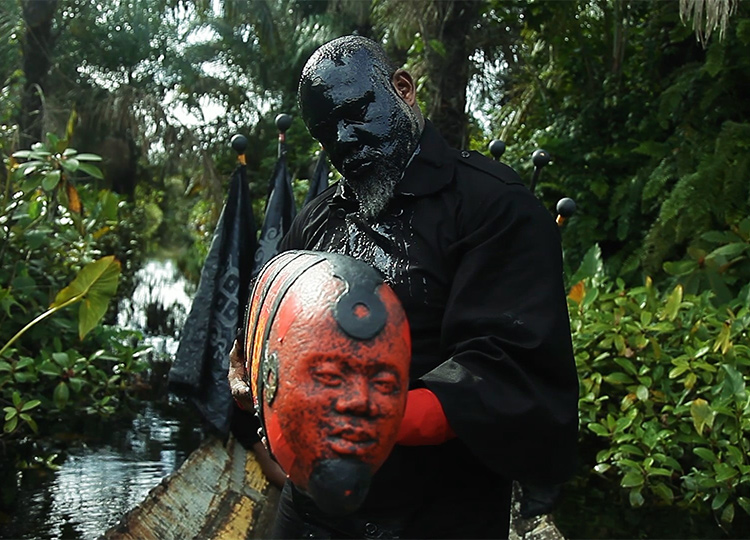Our current exhibition examines western society’s obsession with speed, expansion and resource accumulation and considers the value of ancestral indigenous knowledge at a time when ecological disaster looms. Mónica Alcázar-Duarte: Digital Clouds Don’t Carry Rain is free to visit at Autograph until 1 June 2024.
Here we introduce the artist and the exhibition and provide a glossary of terms that are key to navigating the exhibition.

Mónica Alcázar-Duarte is a multidisciplinary visual artist. Originally from Mexico and of indigenous descent, she now lives and works in the UK. Becoming a migrant shaped her way of seeing and thinking, and it deeply informs her practice. The erasure and loss of indigenous knowledge systems and the need for equality play an important role in her work.
She embraces themes relating to science and technology in her work, exploring their influence over current societal ideals of progress and their impact on the natural world. In her projects she mixes images and new technologies, such as Augmented Reality, to create multi-layered work. In this exhibition, Alcázar-Duarte considers the repercussions of rapid progressions, asking 'who or what might get erased in this process'?
The Maya civilisation dates back to the beginning of recorded history and fell to the Spanish colonial empire in the 17th century. Today, the region comprises of the countries of Guatemala and Belize as well as areas in southeastern Mexico, Honduras and El Salvador.
There are over 6 million contemporary descendants of the Maya civilisation, known collectively as the Maya. The short film that features in this exhibition is narrated in a Mayan language indigenous to Southern Mexico. During the colonisation of Central America, all indigenous languages were eclipsed by Spanish. By harnessing the power of Mayan languages, Alcázar-Duarte seeks to create a counter-narrative that severs the violent taxonomies that uphold colonial power.
You will notice numerous references to Maya concepts, places and people in the exhibition. In particular, Alcázar-Duarte references the burning of the Maya codices - books containing the knowledge and language of the Maya - which took place on 12 July 1562. This act of cultural erasure was led by Diego de Landa, a Spanish bishop of the Roman Catholic faith, who claimed Maya cultures and rituals were ‘evil’.
%20Mo%CC%81nica%20Alca%CC%81zar-Duarte%20-%20Digital%20Clouds%20Don't%20Carry%20Rain%20exhibition%20at%20Autograph.%2016%20February%20-%201%20June%202024.%20Curated%20by%20Bindi%20Vora.%20Photograph%20by%20Kate%20Elliott.jpg)
Copper appears throughout the works in the exhibition referencing the history of copper extraction from Mexico under Spanish colonial rule. These copper details – as seen in the portrait series and the installation at the centre of the gallery – were all added by the artist by hand. By bringing the material to the forefront of her work, Alcázar-Duarte invites the viewer to consider the continued repercussions of such extraction from the land.

The photographic portraits in the exhibition are set amongst the dying trees of Derbyshire, home of the Industrial Revolution. In these self-portraits, the artist mimics poses from 18th-century Casta paintings, a genre of art made in Mexico during Spanish colonialism, illustrating racist social hierarchies.
These illustrations were used during the colonisation of Mexico to differentiate individuals into a caste system and as justification to discriminate against mestizaje (mixed-race) populations. Alcázar-Duarte explains: “In Mexico, a postcolonial country, there is an underlying system of hierarchy and discrimination based on what is perceived as European versus indigenous features.”
The Xunan-Kaab (Regal Lady Bee) are an endangered stingless bee and the central subject of Alcázar-Duarte’s film. First cultivated by the Maya more than 3,000 years ago in the Yucatán Peninsula, the bees are critical to the area’s ecosystem as pollinators of the local rainforest, however deforestation is gravely impacting their numbers.
The honey they produce was an important trade product for the Maya, used not only for consumption but also for its medicinal purposes; Xunan-Kaab honey is understood to have healing properties and has been used since ancient times by the Maya to treat respiratory diseases, strengthen the immune system and slow the growth of glaucoma in the eyes.
By drawing our attention to the complex legacies of the Maya, Alcázar-Duarte poetically asserts the knowledge embodied in nature and the importance of the survival of this invaluable indigenous cultural heritage. Gradually, western science is coming to make space for these learnings.
Flowers, and specifically the lily – as symbolised by the fleur-de-lis – are recurrent features in the exhibition. Used in heraldry to signify monarchy and virtue, the fleur-de-lis symbol was also used during the colonial era to brand enslaved people as a punishment. Here the fleur-de-lis acts as shorthand to bring the history of empire and the natural world into conversation.
Rooted in the centre of the exhibition is a new installation consisting of fifty-six 3D printed lilies, forming a garden of technology which can be activated using an augmented reality app. Alcázar-Duarte coded this display using an algorithm inspired by the collective intelligence of bee colonies – juxtaposing and morphing the form of the fleur-de-lis with faces, gestures and expressions depicted in Casta paintings. The Augmented Reality animates a tree, that seemingly grows from the map of the Yucantán peninsula. As Alcázar-Duarte explains, the Augmented Reality serves as “a tool to expand what is inside the frame of my photographs.”

16 Feb – 1 Jun 2024
Free exhibition

Free to enter | Deadline 4 March 2024
Find out moreBanner image: Mónica Alcázar-Duarte: Digital Clouds Don't Carry Rain exhibition at Autograph. 16 February - 1 June 2024. Curated by Bindi Vora. Photograph by Kate Elliott [detail].
Images on page: 1) Mónica Alcázar-Duarte. Photo by Michael Breakey. 2) Mónica Alcázar-Duarte, Yum Kaax - Mayan Jungle deity, from the series Digital Clouds Don’t Carry Rain, 2021-2023, © and courtesy the artist. 3) Mónica Alcázar-Duarte: Digital Clouds Don't Carry Rain exhibition at Autograph. 16 February - 1 June 2024. Curated by Bindi Vora. Photograph by Kate Elliott. 4) Mónica Alcázar-Duarte, Ah pu’uch - Mayan Death deity, from the series Digital Clouds Don’t Carry Rain, 2021-2023, © and courtesy the artist. 5 - 6) Mónica Alcázar-Duarte, U K’ux Kaj / Heart of sky, Mayan god of storms [film still], 2023-24. 7) Mónica Alcázar-Duarte, Kinich Ahau - Mayan Sun deity, from the series Digital Clouds Don’t Carry Rain, 2021-2023, © and courtesy the artist. 8) Mónica Alcázar-Duarte: Digital Clouds Don't Carry Rain exhibition at Autograph. 16 February - 1 June 2024. Curated by Bindi Vora. Photograph by Kate Elliott.
Other images on the page: 1) Mónica Alcázar-Duarte, Ixchel - Mayan Moon and Birth deity from the series Digital Clouds Don’t Carry Rain, 2021-2023, © and courtesy the artist. 2) Wilfred Ukpong, film still from Earth Sounds, 2021.
Autograph is a space to see things differently. Since 1988, we have championed photography that explores issues of race, identity, representation, human rights and social justice, sharing how photographs reflect lived experiences and shape our understanding of ourselves and others.